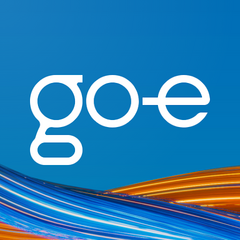go-e app for HOME series (up to V2): Functions & settings
Do you have a go-e Charger from the HOME series (up to V2) and want to change certain basic settings?
Or do you want to find out which functions are available to you in the app to make charging even more convenient?
Then you've come to the right place! Because that's exactly what I'll explain to you in this blog post.
Note: in this blog post we show you the functions of the old app (before 2024) for a go-eCharger of the HOME series (up to V2). If you have a go-e Charger from the Gemini series, you should use the new app.
1. go-e App Download (OLD App)

You can download the go-e Charger app here:
Note: Pay attention to the app logo when downloading. For all go-eChargers of the HOME series up to V2, the go-e app must be downloaded with this app icon (incl. string).
2. Integrate go-eCharger of the HOME series (up to V2) into the app
Before we start, you should know that in order to use the app, you must first integrate your go-eCharger from the HOME series (up to V2) into the app.
3. go-e app: first overview
The first step is to open the go-e Charger app.
You will automatically land on the home screen in the "Charging" tab.
In the centre - in the circle - you can see at a glance whether your car is charging or not and how many kilowatts are being charged. If you click on this circle, you can either start or stop charging.
Do you want to allow Integration of youtube videos?
Allows the playback of videos, that are hosted on youtube.com. By allowing this feature, you accept the privacy agreement of google.
Below the circle you will see three icons for Mode, Power and Scheduled charging.
If you click on the "Mode" icon, you will see the following three modes:
-
ECO mode
-
Scheduled charging mode
-
Flexible electricity tariffs
ECO Mode
"ECO mode" means that charging is carried out as cheaply as possible using flexible electricity tariffs, e.g. aWATTar.
However, the mode is only activated or deactivated here. You can find the mode settings in the "Settings" tab under "ECO mode".
Scheduled charging
"Planned charging mode" means that you can specify the amount of energy to be charged until the next planned journey.
Incidentally, this can also be combined with flexible electricity tariffs so that you can charge as cheaply as possible.
However, the mode is only activated or deactivated here. You can find the mode settings in the "Settings" tab under "Scheduled charging mode."
Flexible electricity tariffs
"Flexible electricity tariffs" are based on the electricity prices on the electricity exchange. Here, for example, you can select your country and aWATTar as your electricity provider. The selection of electricity tariffs is constantly being expanded by go-e.
If you now go back to the start screen, you will see further information under the three icons mentioned, namely
-
Status
-
Energy
-
Information
Status
The status shows you the current status of the go-eCharger, i.e. whether it is ready for charging, whether it is charging or whether the charging process has been completed.
If errors occur, you will also see error messages here. You can view the possible error messages in the operating instructions available online.
Energy
Under Energy, you can see how much charging power your car is currently being charged with, how much energy in kilowatt hours has already been charged during this charging process and the total meter reading of your go-eCharger.
Consumption per user
Click on "Consumption per user" to see an overview of the consumption of individual users, of which you can create a maximum of 10. If someone activates your go-eCharger with a paired RFID chip, their account will be "debited".
If your go-eCharger is connected to our cloud, you can also download this overview by clicking on "Download" and receive comprehensive information on individual charging processes.
Information
Under "Information" you can see information about the connection and also about charging. For example, you can check the voltage, the charging current and the charging power of the individual phases.
4. go-e app settings
If you click on "Settings", you will see numerous setting options.
Setting: Current level
Here you can check or change the 5 levels, which are switched directly on the go-eCharger at the touch of a button. You can therefore decide for yourself how many amps each level should have and can set this yourself before charging at the touch of a button and without an app.
IMPORTANT: The push button only works before charging starts. The button is deactivated during the charging process.
Don't forget to click the save icon after every setting you make so that the changes are also saved. This applies to all settings in the app.
Setting: Kilowatt hour limit
Here you can specify how many kilowatt hours you want to charge in your vehicle. The go-eCharger interrupts charging once the set value has been reached.
As the battery level of the car is not transmitted to the charging station via the type 2 protocol during AC charging, this function still allows you to charge your car to approx. 80% battery level.
The function is also interesting if you live on a mountain, as you can still charge while recuperating during the journey down into the valley.
Setting: Eco mode
The Eco mode, which we mentioned at the beginning, already knows the prices of the set electricity tariff in advance. You can specify the price limit below which the charger should charge. If the price is higher than this, charging will not take place.
I'll just enter 15 cents and the charger will only charge when the price falls below this limit.
Setting: Scheduled charging process
As already mentioned, under "Planned charging process" you can specify the amount of energy to be charged until the next planned journey. If you adjust the consumption to 100 km to your vehicle, this will also be taken into account on the start screen of the app in the "Charging" tab.
To do this, specify the charging quantity, e.g. 20 kWh, and set a time at which the charging quantity you have specified should be completed.
Please do not forget to click on "Save".
The Charger then starts the charging process very briefly to check the maximum charging speed and calculates when charging must be started in order to finish at the time you have selected.
Setting: Car
In the "Car" settings, you can define some car-specific settings that enable smooth smart charging.
If you select a car that has already been saved, the other settings are adjusted automatically.
Setting: Charging timer
Here you can set the times at which charging should be enabled or blocked.
The charging process is only started as soon as other functions such as access control and flexible electricity tariffs allow charging.
The charging process is only ended one minute after the set time.
Please note, however, that a time must be set for this mode in the time settings of the app.
You can make the settings for a weekday in the first tab and for the weekend in the other two tabs.
Setting: Load management
If you have several go-eChargers, you should use load management to prevent your power connection from being overloaded.
Here you can specify, for example, that two go-eChargers charging simultaneously should not use more than a total of 20 kW for charging.
Generate group ID for load management
So that your go-eChargers also know which other go-eChargers they need to exchange with, it is necessary to include them in the same group.
For the first go-eCharger, simply click on "Generate group ID", which will automatically generate this for the first Charger.
It is best to copy the generated group ID or write it down, as you will need to enter it for your other go-eChargers.
Set maximum total current
Here you can specify the maximum total current that should be available to your go-eChargers.
This depends on the amount of current that your connection can provide.
However, make sure that you do not set the value too high, as you should also take into account other power consumers in the building.
When your chargers communicate with each other and divide up the available charging current, they refer to this value.
Please make sure that this value is the same for all go-eChargers at this connection.
Set charging priorities
If you want to set the charging priority for the go-eCharger, you can do so here. This means you can specify which chargers should charge with the maximum charging current and which should charge more slowly or wait.
Incidentally, one is the highest priority.
If you want to divide the charging current fairly, simply give all go-eChargers the same priority.
Max. Current in fallback mode
This setting is important as the load management of the go-eCharger is carried out via our cloud. To access the cloud, your go-eChargers naturally need an active internet connection.
If the internet connection is suddenly lost, your go-eChargers can no longer communicate with each other. The fallback mode interrupts charging in the default setting [value = 0] and does not allow any new charging.
If you want your go-eCharger to continue charging anyway, you can set the charging current with which it can charge during the outage.
Please note that you need at least 6 A per go-eCharger to start a charging process.
Make absolutely sure that the sum of this setting for all go-eChargers does not exceed the previously made ‘Total current’ setting.
5. Further app settings
Let's now take a look at a few other settings to customise your go-eCharger as much as possible to your personal needs.
Customise the name of the go-eCharger of the HOME series (up to V2)
If you like, you can customise the name of the go-eCharger in the app.
Changing the brightness of the LEDs
You can also adjust the brightness of the LEDs on the go-eCharger. If the LEDs are too bright for you, simply reduce their brightness. If you want to switch off the LEDs after 10 seconds in standby mode, you can do so here.
Changing the colour of the go-eCharger LEDs
In the "LED colours" settings, you can adjust the colours depending on the status. If you want the charging process to be displayed in yellow, click on "Charging" and set the colour accordingly.
Set time
In some cases, it is necessary to adjust the time. For example, if you need to restart the charger or there has been a power failure. You can make time settings here.
go-eCharger access management via RFID chip
Another customisation worth mentioning is access management.
If you want authentication via RFID chip or app to be required to start the charging process, you can select this here.
The default setting is "Open". This means that no authentication is required to start charging.
If you install the charger outside the building, you probably do not want other people to charge on your charger.
The RFID chip supplied with the charger is already programmed. However, you can also teach in almost any RFID chip yourself.
